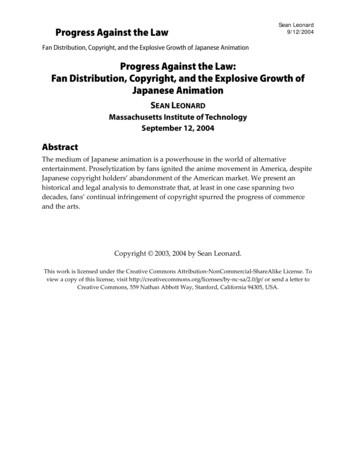
Transcription
Progress Against the LawSean Leonard9/12/2004Fan Distribution, Copyright, and the Explosive Growth of Japanese AnimationProgress Against the Law:Fan Distribution, Copyright, and the Explosive Growth ofJapanese AnimationSEAN LEONARDMassachusetts Institute of TechnologySeptember 12, 2004AbstractThe medium of Japanese animation is a powerhouse in the world of alternativeentertainment. Proselytization by fans ignited the anime movement in America, despiteJapanese copyright holders’ abandonment of the American market. We present anhistorical and legal analysis to demonstrate that, at least in one case spanning twodecades, fans’ continual infringement of copyright spurred the progress of commerceand the arts.Copyright 2003, 2004 by Sean Leonard.This work is licensed under the Creative Commons Attribution-NonCommercial-ShareAlike License. Toview a copy of this license, visit p/ or send a letter toCreative Commons, 559 Nathan Abbott Way, Stanford, California 94305, USA.
Leonard, Sean9/12/2004Progress Against the LawTable of Contents1. Introduction . 52. Anime and Its Fandom: A Primer for Non-Fans. 82.1. Anime . 82.2. Fan Distribution . 102.3. Fansub. 103. Historical Analysis of Fan Distribution and Subtitling . 133.1. Pre-Fan Period . 133.2. Technology Change; Cartoon/Fantasy Organization . 153.3. Japanese Enter and Abandon the Market. 183.4. Fan Activity Increases . 233.5. Anime Importers Fail to Release Quality Material . 283.5.1. The Robotech Exception and the Second Wave . 313.6. C/FO at Its Height; C/FO in Japan . 343.7. C/FO Fan Distribution. 383.7.1. Fan Networks as Proselytization Commons. 413.8. Birth of Fansubbing; Collapse of C/FO . 423.9. New Clubs, New Fans, New Fansubbing . 453.9.1. Reverse Imperialism . 483.9.2. Organizing an Open Proselytization Commons . 493.10. Conventions . 523.10.1. AnimeCon ’91 . 523.10.2. Anime Expo and Anime America 1992-1993 . 553.10.3. Fansubbing and its Causal Link to Licensing . 573.10.4. Fansubbing vis-à-vis Bootlegging. 593.10.5. Preparation, Distribution, and Exhibition of Fansubs. 613.11. Industry . 653.11.1. A.D. Vision. 653.11.2. AnimEigo . 663.11.3. Streamline Pictures . 673.11.4. Pioneer LDC. 703.12. Success Returns to Japan. 713.13. Concluding the Historical Analysis . 734. Legal Analysis of Fan Distribution and Subtitling. 794.1. Basics of International Copyright Law . 794.2. Copyright in Japanese Animated Works in Japan . 814.2.1. What Is Owned and Who Owns It . 82Version 1.11Page 2 of 103
Leonard, Sean9/12/2004Progress Against the Law4.2.2. Domestic and International Rights of These Owners. 834.3. Time-Shifting/Fan Recording from America . 854.4. Sharing Among Friends . 864.5. Showings at Clubs. 874.6. Copying and Sending Across Country . 874.7. Pen Pals in Japan . 884.8. Renting at Mom and Pop Stores . 914.9. Recording Anime from Japan and Sending Them to America . 934.10. Translation . 964.11. Fansubbing. 974.12. Distributing Fansubs Before and After Licensing . 974.13. Before We Conclude . 984.14. Concluding the Legal Analysis . 995. Progress Against the Law . 100Citation and Romanization FormatsExcept in “Legal Analysis of Fan Distribution and Subtitling,” citations adhere tothe MLA style with footnotes.1 In “Legal Analysis of Fan Distribution and Subtitling,”citations adhere to the Bluebook style.2Japanese to English transliteration is littered with exceptions and discrepancies.For Japanese proper names, this analysis adheres to the person’s preferredRomanization if known. If the person has no known Romanization, this analysis usesthe popular usage of the person’s name in anime-related discourse. In most cases,names are specified in Western style, with given name first and family name last.Subsequent references to the person employ his or her last name only.Japanese anime titles are referenced in the text according to their prevailingEnglish-language designation during the time period. For example, the text employsVersion 1.11Page 3 of 103
Leonard, Sean9/12/2004Progress Against the LawSpace Battleship Yamato, not Uchū Senkan Yamato, 宇宙戦艦ヤマト, or Star Blazers;however, the text uses Star Blazers when it specifically discusses that adaptation. Ifsignificant discrepancies exist between the original Japanese, common English, andAmerican commercial titles, an endnote at the first instance of the title will furnish all ofthe Japanese and English titles.Foreword and AcknowledgementsVersion 1.0 of this document was prepared December 10, 2003 to partially fulfillthe requirements for MIT 6.806: Ethics and Law on the Electronic Frontier, under theinstruction of Prof. Harold Abelson and Daniel Weitzner. I am grateful for theirinstruction, support, and encouragement.Gibaldi, Joseph et. al. MLA Style Manual: Second Edition. New York: Modern Language Association ofAmerica. 1999.2 Harvard Law Review Staff. Uniform System of Citation: The Bluebook. Cambridge, MA: Harvard LawReview Association. July 1996.1Version 1.11Page 4 of 103
Progress Against the LawSean Leonard9/12/2004Fan Distribution, Copyright, and the Explosive Growth of Japanese Animation1. IntroductionInterest in, and consumption of, Japanese animation has increased exponentiallyacross the world in the last ten years. Total sales of anime and related character goodsrose to 9 trillion (US 80 billion) in 2002, up from less than a tenth of that a decadeearlier.3 Despite Japan’s flagging revenues in other markets from steel to manufacturingand heavy industry, the Wall Street Journal recently commented that “Japan has morethan made up for it because of its cultural exports.”4 Indeed, Prime Minister JunichiroKoizumi lauded anime in his 2003 opening speech to the Diet. Using Spirited Away as apointed example, Koizumi asserted that anime has become “the savior or Japaneseculture.”5 Considering all of this “hype,” we ask the question: how did anime, onceregarded as a product produced for and consumed by Japanese children, become such apowerhouse in the global media market?The answer lies in the international pull, not push, of anime to other nations’shores. A wave of internationals became interested in anime, manga (Japanese comics),and other cultural products as they studied or served in the military in Japan in the1960s and 1970s, at the very moment that the slogan “Japan as No. 1” began to reshapethat country’s popular consciousness. Those who returned to America wanted to shareanime and manga with their friends. The introduction of the VCR into the Americanand Japanese mass markets in 1975 made this possible: for the first time, fans could tape
Leonard, Sean9/12/2004Progress Against the Lawshows to show others in America.6 Initially unable to share because of the JapaneseEnglish language barrier, fans were relegated to explaining the bare basics of an animeplot as a slew of fantastic imagery and incomprehensible language bombardedaudiences at the back of science-fiction conventions. Worse yet, a reader might strugglewith the “backwards text and images” of manga alongside a Japanese-competent friend.As Henry Jenkins once commented about this period, “We didn’t know what the hellthey were saying, but it looked really cool.”7New technology and distribution networks quickly enabled fans to proliferatetheir anime message. What followed was the birth of fan distribution—a process ofreleasing anime shows on a vast underground network of fans throughout the country.Following a shift in the constitution of the fandom, fansubbing, or translation andsubtitling of anime videos, was added to the distribution process by 1990. After leavingcollege, many fans started anime companies, becoming the industry leaders of today.Anime fan distribution networks—networks of Japanese animation fans whoimported and distributed videos over a vast underground network in the United Statesfrom the 1970s through the early 1990s—represented proselytization commons, or spaceswhere media and ideas could be freely exchanged to advance a directed cause. Uponthese networks many built their fortunes, and many more spread the knowledge andenthusiasm of Japanese animation to their American counterparts, all years before theVersion 1.11Page 6 of 103
Leonard, Sean9/12/2004Progress Against the Lawwidespread adoption of the Internet. This dissemination flouts theories of globalizationas directed by American cultural imperialism, for Americans “pulled” Japanese culturalproducts to America en masse without coercion by Japanese industry. Translation,reconstitution, and reproduction were not antagonistic to profit-making in early animehistory; indeed, this fan process acted as a prerequisite good/service combination towidespread commercial exploitation. Fans, distributors, and producers alike furtherbelied that these fan processes were necessary. Quite against the restrictions ofcopyright, fan distribution of anime flourished throughout the 1970s through 1990s tocatalyze a nascent domestic industry and to impel the progress of the arts.The remainder of the paper is organized as follows. In the second section, weprovide a primer for readers who are unfamiliar with the terms “anime,” “manga,” “fandistribution,” and “fansub,” terms that this analysis will use heavily. In the third section,we detail the history of the anime fan phenomenon as it relates to the development ofanime interest in the United States, unpacking the processes and motivations of keyplayers in the movement between 1976 and 1993. We construct an historical argumentbased on original interviews and primary sources, ultimately determining that fandistribution functioned economically as a prerequisite good to licensed materials. In thefourth section, we present a legal analysis of fan distribution and fan activities, drawingfrom Japanese copyright law, American copyright law, and relevant copyrightVersion 1.11Page 7 of 103
Leonard, Sean9/12/2004Progress Against the Lawimplementation treaties in effect during the period under examination. We determinethat fan distributors were left with no recourse to committing copyright infringement inorder to satisfy their goals. In the final section, we combine these analyses to assert thata sphere of economic activity was created that existing copyright regimes would havedenied, directly contributing to the rapid explosion in anime consumption and profitfor all parties involved.2. Anime and Its Fandom: A Primer for Non-Fans2.1. Anime“Anime” is the French abbreviation for animation, a word that the Japaneseadopted to describe all animation. In America, “anime” specifically refers to theJapanese product, and is used for both the singular and the plural. The first Japaneseanimated film was a 5-minute short film called Mukuzo Imokawa the Doorman (MukuzoImokawa Genkanban no Maki) produced by Oten Shimokawa in 1917.8 Various animewere produced throughout the prewar and wartime periods, but animation remained acurious oddity until 1958, when animation studio Toei Doga released Hakujaden (TheGreat White Snake),9 the first full-length, color anime film. Most historians cite 1963 asthe birth of the anime industry, when famed manga artist and animator Osamu Tezukareleased Tetsuwan Atomu (Astro Boy in the US),10 solidifying the long-standingVersion 1.11Page 8 of 103
Leonard, Sean9/12/2004Progress Against the Lawconnection between anime and manga and inculcating millions of Japanese youth withthe love of a super-robot who looked and acted just like a real boy.Anime is created for three distinct venues in Japan: television, theatrical release,and direct-to-video (OVA, or Original Video Animation). OVAs evolved from MamoruOshii’s 1983 Dallos, and from the mid 80s to the mid 90s became the dominant venue forexperimental or avant-garde animation. Variety in anime is both abundant and scarce:today, there are over eighty anime productions airing on TV every week. This figuredoes not include theatrical and OVA offerings, which would bring the number closer to130. However, some animators, such as Hayao Miyazaki, complain that the rapidexpansion of the anime industry has resulted in a dearth of creativity that is leading theindustry to a dead-end.11Interest in Japanese animation in America has occurred in waves,12 each of whichleft a rising wake of anime fans who extol the virtues of the medium as an alternative toboth Hollywood and any other products of American popular culture.13 The first waveoccurred in the 1960s with Astro Boy (1963) and Speed Racer (1968, originally Mach Go GoGo). Star Blazers arrived in the United States in 1978 (originally Space Battleship Yamatofrom 1974), followed by Robotech in 1985 (based on three series from 1982 onward).Akira was a major cult hit in 1988. Finally, the 90s gave way to an exponential rise ofVersion 1.11Page 9 of 103
Leonard, Sean9/12/2004Progress Against the Lawtitles and anime interest. Some of the highlights include Sailor Moon (1995),Dragonball/Dragonball Z (1995), Pokémon (1998), and Princess Mononoke (1999).2.2. Fan DistributionFan distribution comprises all of the methods by which fans copied anddisseminated anime to other fans between 1976 and 1993.2.3. FansubFansub is short for fan subtitling, or fan-subtitled video. Fansubs are almostexclusively subtitles of anime. Fansubs appeared in America in 1989 following the wideconsumer availability of Commodore Amiga and Macintosh computers, which couldoverlay subtitles on top of a video stream with extra hardware. The essential hardwarefor fansubbing between 1989 and 1998 was a genlock, or generator locking device. Thisdevice enables a video machine, such as a TV, to accept two signals simultaneously.When operational, a genlock synchronizes an incoming video signal with computeroutput, enabling the overlay of subtitles in real-time. The results of a genlock systemwere then recorded on another videocassette and distributed along a vast fan network.Many fansubbers incorporated time-synchronized VHS and S-VHS decks into theirfansubbing systems; by the mid 90s, these systems allowed for near-perfect timing andaccuracy of subtitles and spoken dialogue.Fans who subtitle videos are called fansubbers; a team of fansubbers is known asa fansub group. A fansub group traditionally consists of one or more translators, editors,Version 1.11Page 10 of 103
Leonard, Sean9/12/2004Progress Against the Lawtypesetters, timers, and first-tier distributors. Fansubbers usually add credits oridentifying marks to their works, although they almost always use pseudonyms forlegal reasons. Fansubbers additionally will add titles such as “NOT FOR SALE ORRENT” and “CEASE DISTRIBUTION WHEN LICENSED” to their works, indicatingthat their works are not licensed, that no money should change hands for their fansubs,and that viewers should purchase the licensed products once they are availabledomestically. Many fansubbers and distributors used the self-addressed, stampedenvelope (SASE) system of distribution. This system required no monetary exchange.Instead, fans would send a self-addressed, stamped envelope with blank tapes andinstructions in it; they would get the tapes back with the episodes recorded on them.Some fansubbers, however, charged modest fees ostensibly to cover the cost of the tapeand postage.Many fansubbers would include explanatory subtitles or supertitles about Japan,Japanese culture, or other tidbits of a subtitled anime in order to elucidate the show’smore elusive references.As this analysis ends at 1993, it does not cover fansubs encoded in video files anddistributed over the Internet, also known as digisubs. Digisubs first appeared in the late1990s.34Korea government survey, 2002.Associated Press. Wall Street Journal. 17 Apr. 2003.Version 1.11Page 11 of 103
Leonard, Sean9/12/2004Progress Against the Law“The Hollowing Out of Japan’s Anime Industry.” Mainichi Interactive. 25 Feb. 2003. 0030225p2a00m0oa024000c.html 8 May 2003.6 “1975: Sony Betamax Combination TV/VCR Released in the U.S.” CED Magic: Pictorial History of MediaTechnology. http://www.cedmagic.com/history/ 8 Dec. 2003.7 Jenkins, Henry. Personal Interview. 28 August 2000.8 Clements, Jonathan and Helen McCarthy. The Anime Encyclopedia. Berkeley: Stone Bridge Press, 2001. p.283.9 Hakujaden. 白蛇伝. Legend of the White Snake. Panda and the Magic Serpent. 22 Oct. 1958. Data source:“Anime News Network – Hakujaden (movie).” Anime News Network Encyclopedia. 2004. .php?id 655 28 Apr. 2004.10 Astroboy 1. “Tape One: Birth of Astroboy; The Monster Machine.” Prod. Osamu Tezuka and Fred Ladd.Distr. The Right Stuf, Inc. 1963, NBC Films; 1991, The Right Stuf, Inc.11 Kitano, Masayuki. “Miyazaki says Japan animation faces dead end.” Japan Today. 20 Feb. 2002. http://www.japan-today.com/ 15 Mar 2002.12 Omega, Ryan. Anime Trivia Quizbook, Episode 1. Berkeley: Stone Bridge Press, 1999.13 Napier, Susan. Anime: From Akira to Princess Mononoke. Hampshire, England: Palgrave Press, 2001.5Version 1.11Page 12 of 103
Progress Against the LawSean Leonard9/12/2004Fan Distribution, Copyright, and the Explosive Growth of Japanese Animation3. Historical Analysis of Fan Distribution and SubtitlingWe present an original history of the fan movement in the United States. Thishistory has been compiled and verified from a series of personal interviews, fan artifacts,and other primary sources. We provide appropriate citations for known references fromthis period.3.1. Pre-Fan PeriodJapanese animation entered the United States before 1975, but with varyingdegrees of adaptation. The first documented films that were distributed across theUnited States were Panda and the Magic Serpent (Hakujaden) starting March 15, 1961,followed by Magic Boy (Shōnen Sarutoki Sasuke) on July 8, 196114 and Alakazam the Great(Saiyūki) on July 26, 1961.15 While American producers had to stick fairly close to whatwas onscreen for the graphics, they changed much of the story to cater to Americanchildren’s perceived tastes. Fred Ladd, who produced the American versions of AstroBoy (1963), Gigantor (1965), Kimba the White Lion (1965), and Speed Racer (1967), wasnotorious for changing names16 and editing plotlines. Before Astro Boy, Ladd wasinvolved with a Belgian production doing a modernization of Pinocchio called Pinocchioin Outer Space. When NBC bought the rights to Tetsuwan Atomu in 1963, the companycontacted Ladd because of his previous work, which was similar to Tetsuwan Atomu.However, these similarities were tenuous at best. American production companies were
Leonard, Sean9/12/2004Progress Against the Lawused to completely Americanizing foreign products, removing un-American speech aswell as all but the most scant of references to the original Japanese production teams.These shows turned out to be enormously popular with Americans, however,and there is little doubt that Ladd contributed towards the short-lived success ofJapanese animation in the 1960s. Nevertheless, pressure to sanitize children’s televisionin 1970s America paralleled dramatic advances in violence and sexual content inJapanese animation, largely due to the influence of Go Nagai’s Devilman (1972),Mazinger Z (1972), and Cutey Honey (1973). American networks decided to move cartoonshows from weekday primetime—the former home of Astro Boy and Speed Racer,alongside the classic The Flintstones and The Jetsons—to Saturday mornings, at whichpoint a variety of parent groups pressured the networks for an increased sanitization ofanimated programming. Ladd points out, “You couldn’t give away a Japanese-madeseries here [by the early 1970s].”17A few Japanese cartoons did make it over to the US and are worth noting.Gatchaman (as Battle of the Planets, later G-Force) was brought over in 1978. The formerproduction was significantly sterilized, and both productions remained too unpopularto be sustained on American television. Space Battleship Yamato aired in 1978 withminimal retooling as Star Blazers, proving more successful. Its popularity was confinedto the East Coast, however, explaining the prevalence of East Coast Star Blazers fandom.Version 1.11Page 14 of 103
Leonard, Sean9/12/2004Progress Against the LawFinally, Voltron18 made significant inroads into the children’s market in America in 19841986; its sanitization could be described as halfway between Star Blazers and Battle of thePlanets. In all these cases, however, shows’ Japanese origins were strictly eradicated.Japanese animation interest would surface again in the next decade, but its driving forcewas a very different market: the micro-market created by fans.3.2. Technology Change; Cartoon/Fantasy OrganizationPost-Astro Boy anime penetration spread through the United States within threemonths of the release of the first video cassette recorders in November 1975. By March1976, Japanese community TV stations in the United States started running subtitledgiant robot cartoons, such as Getter Robo. These stations had been running Japanesecartoons beforehand, but their previous broadcasts were aimed at very young children.Thanks to the availability of VCRs, science fiction and comics fans could record thesenew shows and show them to their friends.Fred Patten, founder of the first anime club in the United States, described hisexperience in detail. Patten’s first exposure to anime occurred at the Los AngelesScience Fiction Society (LASFS) in 1976. During one of the weekly meetings, Patten metup with another fan who was an early adopter of Sony’s Betamax technology. The fansaid, “You’ve got to look at this recording I made of this Japanese science fictionanimated cartoon,” and proceeded to show it at one of the society’s meetings.Version 1.11Page 15 of 103
Leonard, Sean9/12/2004Progress Against the LawOver the next year, the fan brought a number of recorded Japanese giant robotcartoons with English subtitles to the science fiction club. Additionally, several otherfans recorded shows from Japanese community TV and showed them at various fanevents. At the time, fans were amazed that the Japanese cartoons depicted so muchmore violence than cartoons in the United States. A standard plot device in theJapanese cartoons, for example, was that the hero’s father had been killed by the villain,that entire cities were blown up, and that the hero had to survive in the aftermath of aruined world.19 Whether or not these cartoons showed any graphic bloodshed, it wasobvious that hundreds of thousands of people were supposed to have been killed. InAmerican cartoons from 1976-1980, no one was ever hurt in even the so-called actionadventure, or superhero, cartoons. Villains in American cartoons could do little morethan make a few ugly faces.In 1977, a small group of fans, Patten included, decided that they liked theJapanese cartoons so much that they should found a separate club so that they couldwatch them on a regular basis, instead of watching them at odd hours at a general fanparty. At these fan parties, it was common for a proponent of a Japanese cartoon topropose to watch it, but he—usually he at the time—would be voted down by themajority who preferred American fare. In May 1977, these fans started theVersion 1.11Page 16 of 103
Leonard, Sean9/12/2004Progress Against the LawCartoon/Fantasy Organization (C/FO), meeting regularly on the third Saturday of eachmonth.In November 1977, fans from the C/FO in LA started corresponding with otherJapanese animation fans around the country. They found out that while they wereshowing Japanese cartoons in other cities, the cartoons were not always the same. LosAngeles and New York City were getting different sets of cartoons: New York wasgetting Cyborg 00920 and Galaxy Express 999,21 for example, which were not being shownin Los Angeles. Consequently, the fans started trading tapes back and forth.At that time, many LASFS members maintained pen pal relationships with otherscience fiction fans around the world. Most of them were in English-speaking countries,but a few of them had correspondents in Japan. As a result, C/FO members began totrade videos with Japanese fans who wanted Star Trek and Battlestar Galactica. C/FOmembers were interested in the Japanese science fiction cartoons that were not beingshown in Los Angeles television, and it was a fortunate coincidence for the fans thatboth the United States and Japan used the NTSC system for broadcast, so that videotapes could be played in both countries.Of course, the tapes that the fans received from Japan were not subtitled at all:fans had to watch them in pure Japanese. By the late 1970s, the majority of Japanesecartoons remained simple enough so that the average viewer could discern their plotsVersion 1.11Page 17 of 103
Leonard, Sean9/12/2004Progress Against the Lawjust from watching their visuals, such as in Space Battleship Yamato (1974) and SpaceBattleship Yamato 2 (1978). Because there was no other alternative, fans reported thatthey were happy enough to watch untranslated shows. By 1979, fans and clubs, whohad recently established an independent identity from the science fiction movement,began using the term anime.C/FO was not the only anime club in existence by this time. For instance, therewere very big fan clubs in Boston, in New York, and in Philadelphia. There was amobile fan club on the East Coast that called itself the Gamelan Embassy, named afterthe antagonists from Space Battleship Yamato. The Gamelans were devoted to showingJapanese animation at the science fiction and comic book conventions in the NewEngland and Mid-Atlantic regions. Starting in 1980, they would show anime programsin one of their hotel rooms at science fiction conventions. The Gamelans put out fliersthroughout these conventions, reading, “If you want to see Japanese animation come upto room XYZ,” and, “We’re go
The answer lies in the international pull, not push, of anime to other nations’ shores. A wave of internationals became interested in anime, manga (Japanese comics), and other cultural products as they studied or served in the military in Japan in the 1960s and 1970s, at the very











